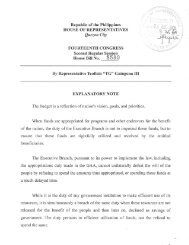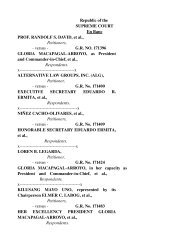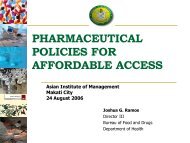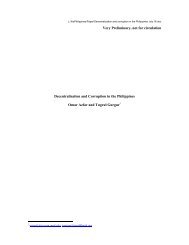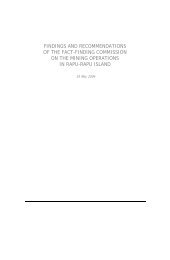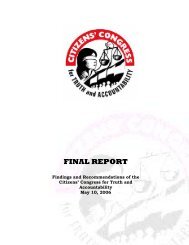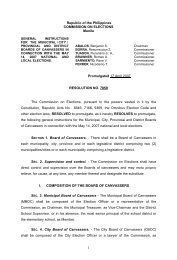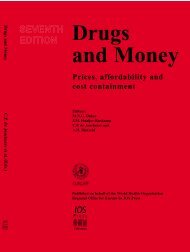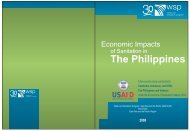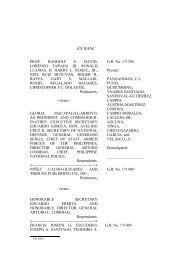i Report Issue No. 3 2005 - Philippine Center for Investigative ...
i Report Issue No. 3 2005 - Philippine Center for Investigative ...
i Report Issue No. 3 2005 - Philippine Center for Investigative ...
You also want an ePaper? Increase the reach of your titles
YUMPU automatically turns print PDFs into web optimized ePapers that Google loves.
V O I C E S F R O M T H E P E R I P H E R Y<br />
The time <strong>for</strong><br />
federalism is now<br />
REY MAGNO TEVES<br />
where<br />
MAKE NO mistake<br />
about<br />
it. While the<br />
packed gallery’s<br />
enthusiastic<br />
applause<br />
<strong>for</strong> the president’s<br />
last State of the Nation Address<br />
reeked of hakot (paid audi-<br />
ence), there was some measure<br />
of spontaneity particularly from<br />
the promdis—also known as lo-<br />
cal government officials —who<br />
were dressed to the nines.<br />
The grins were genuine when<br />
President Gloria Macapagal-Arroyo<br />
said it was time to start the charter<br />
debates. Bigger cheers came<br />
when the president announced<br />
her preference <strong>for</strong> a shift from the<br />
unitary system of government to a<br />
federal one. There was also loud<br />
clapping when she mentioned a<br />
change from the presidential to a<br />
parliamentary <strong>for</strong>m.<br />
But it’s safe to assume that the<br />
idea of federalism resonated better<br />
among the local government<br />
executives than the notion of<br />
parliamentary government. After<br />
all, the local governments would<br />
be clear beneficiaries of a federal<br />
system that by definition disperses<br />
political power to the regions.<br />
Under the present system,<br />
regional development has been<br />
uneven and inequitable, and there<br />
has been creeping realization—especially<br />
in the countryside—that<br />
it is no longer just a question of<br />
having good and effective leaders.<br />
We’ve had dramatic leader changes<br />
in the past two decades, but there<br />
seems to be no parallel profound<br />
trans<strong>for</strong>mation in the lives of the<br />
people. Most of us are still in a<br />
rut, and the way out looks like it<br />
involves a change in the system.<br />
Which is probably the reason<br />
why the current brouhaha seems<br />
confined in the National Capital<br />
Region. Even civil society groups<br />
in the Visayas and Mindanao<br />
who were active in Edsa 1 and<br />
Edsa 2 have been conspicuously<br />
silent. They’re apparently done<br />
with just leader changes, and<br />
personality-oriented politics<br />
controlled by imperial Manila.<br />
That’s coming from places<br />
poverty and deprivation<br />
are deepest. Indeed, areas farthest<br />
from the capital experience more<br />
savage poverty and injustice. The<br />
Autonomous Region of Muslim<br />
Mindanao (ARMM), Caraga (Agusan<br />
and Surigao provinces), Bicol,<br />
Samar, and Leyte are among the<br />
regions that bear the brunt of the<br />
center’s neglect. These are also<br />
the areas that have bred numerous<br />
insurgents and continue to<br />
fuel uprisings and rebellion.<br />
MINDANAO AND<br />
SEPARATISM<br />
Of course, when it comes to rebellion,<br />
Mindanao is the first that<br />
comes to mind. It is the home<br />
of the Moro National Liberation<br />
Front (MNLF), which fought <strong>for</strong><br />
independence until it agreed in<br />
1996 to a measure of autonomy<br />
under the Southern <strong>Philippine</strong>s<br />
Council <strong>for</strong> Peace and Development<br />
framework. Today the MNLF<br />
is somewhat disjointed, with some<br />
elements tending back toward<br />
separation even as many of its<br />
leaders (or <strong>for</strong>mer leaders) sit in<br />
Congress, as well as in local governments<br />
as governors and mayors,<br />
and also in jail (specifically<br />
founder-chairman Nur Misuari).<br />
Mindanao is home as well to<br />
the presently more potent Moro<br />
Islamic Liberation Front (MILF),<br />
which has carried the torch of independence<br />
since splitting from<br />
the original MNLF in 1976. Four<br />
years ago, it began engaging<br />
the <strong>Philippine</strong> government in a<br />
peace process. It didn’t drop its<br />
demand <strong>for</strong> independence, but<br />
it has expressed willingness to<br />
discuss other options “short of<br />
outright independence but more<br />
than autonomy.”<br />
The MILF, though, has rejected<br />
the current movement <strong>for</strong><br />
a Mindanao Republic, particularly<br />
that version being espoused by<br />
the group called One People<br />
Mindanao (OPM). In a recent<br />
official statement, the MILF said,<br />
“We cannot endorse anything that<br />
we are not a party to, and where<br />
the programs <strong>for</strong> the Bangsa<br />
Moro people are not clear.”<br />
Be that as it may, Muslim<br />
rebels and activists have long lost<br />
their monopoly on separatism.<br />
Although the latest Bright Idea is<br />
not directly connected with two<br />
previous Mindanao Independence<br />
Movements (MIM One under<br />
the late Datu Ugtog Matalam<br />
in the 1970s, and MIM Two under<br />
Reuben Canoy in the late 1980s),<br />
it certainly draws from the same<br />
logic and circumstances that propelled<br />
those MIMs. It there<strong>for</strong>e<br />
cannot be dismissed easily.<br />
Then there’s Davao Ciy Mayor<br />
Rodrigo Duterte’s pronouncement<br />
that he is ready to set up a separate<br />
Mindanao Republic. It may not<br />
be a serious, organized challenge,<br />
but it’s not exactly an empty<br />
threat, since it is premised on the<br />
possibility, remote or otherwise,<br />
that President Arroyo would be<br />
removed from office unconstitutionally.<br />
It’s even been adopted<br />
by the Confederation of Mindanao<br />
local government executives, and<br />
then echoed in Ilocos by Gov. Luis<br />
‘Chavit’ Singson and in the Visayas<br />
by a convention of leaders. Which<br />
means Mindanao itself cannot<br />
claim to have a monopoly on having<br />
separatist sentiments.<br />
CITIZENS FOR<br />
FEDERALISM<br />
Federalism, however, offers<br />
another alternative to those of<br />
us in the peripheries who have<br />
suffered because of policies<br />
emanating from a callous center.<br />
It seems to be a no-brainer. Yet<br />
be<strong>for</strong>e the Citizens Movement<br />
<strong>for</strong> a Federal <strong>Philippine</strong>s (CMFP)<br />
was launched in February 2003<br />
in Marikina City, there seemed to<br />
be no nationwide ef<strong>for</strong>t toward<br />
federalism. Instead, many of the<br />
calls came individuals.<br />
During the 1970 Constitutional<br />
Convention, several proposals<br />
touting federalism were submitted.<br />
Oldest delegate Antonio<br />
de las Alas proposed a Federal<br />
<strong>Philippine</strong>s with 20 autonomous<br />
states similar to Swiss cantons. UP<br />
professor Leopoldo Yabes, meanwhile,<br />
called <strong>for</strong> the creation of 10<br />
states with smaller units patterned<br />
after the U.S. county system. Yet<br />
another suggestion was <strong>for</strong> three<br />
main geographical subdivisions:<br />
Luzon, Visayas, and Mindanao.<br />
<strong>No</strong>ne of the proposals, however,<br />
went beyond committee.<br />
In 1982, a new national political<br />
party spearheaded by Mindanaoan<br />
Aquilino Pimentel Jr. had<br />
federalism as part of its main political<br />
plat<strong>for</strong>m. This was the Pilipino<br />
Democratic Party or PDP, which<br />
later merged with Benigno ‘Ninoy’<br />
Aquino Jr.’s Lakas ng Bayan or Laban<br />
to become PDP-Laban. But the<br />
party has not really pushed hard<br />
<strong>for</strong> federalism, not even during the<br />
drafting of the 1987 Constitution,<br />
which eventually rein<strong>for</strong>ced the<br />
unitary system.<br />
In the 1992 national elections,<br />
a group called PILIPINAS 92<br />
espoused federalism. But the organization<br />
proved to have a short<br />
life, partly because it got identified<br />
with an aborted presidential<br />
bid of then Senator John Osmeña,<br />
who was its founding chair.<br />
In 1998, Senators Pimentel,<br />
John Osmeña, and Francisco Tatad<br />
filed a joint resolution calling <strong>for</strong><br />
a constitutional convention or<br />
con-con to adopt a federal system<br />
of government. It also did not go<br />
beyond committee. Pimentel is the<br />
only one among the three left in<br />
the Senate. He continues to champion<br />
federalism all by his lonesome<br />
there, yet he has now taken a stand<br />
as well against charter change.<br />
Because it is citizen-led and<br />
citizen-run, the CMFP believes it<br />
has a good chance of keeping the<br />
idea of federalism alive. It will also<br />
be able to spread the word faster<br />
across the country. Organized<br />
by the Lihok Pideral Mindanaw<br />
(LPM), the CMFP’s basic strategy is<br />
networking and alliance building,<br />
including with elected leaders and<br />
politicians. It now has core groups,<br />
chapters, and allied networks in all<br />
of country’s 17 regions. It has also<br />
helped <strong>for</strong>m a national alliance<br />
<strong>for</strong> the establishment of a Federal<br />
Parliamentary <strong>Philippine</strong>s through<br />
a constitutional convention. It is<br />
this mode of charter change, and<br />
not via a “con-ass” or constituent<br />
assembly, that the CMFP and its<br />
allies are fighting <strong>for</strong>.<br />
<strong>No</strong>w more than ever, the CMFP<br />
slogan is apt: Federal <strong>Philippine</strong>s,<br />
Panahon Na (It’s Time)!<br />
Rey Magno Teves, a longtime<br />
advocate of federalism, is chair<br />
and convenor of Lihok Pideral<br />
Mindanaw.<br />
PHILIPPINE CENTER FOR INVESTIGATIVE JOURNALISM<br />
I REPORT<br />
29



